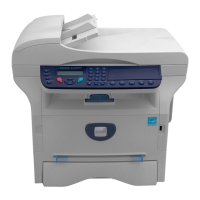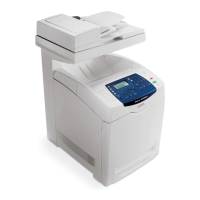09/2007
6-14
Phaser 8860/8860MFP Service Manual
Print Engine Check Menu Tests
Initial Issue
Diagnostics
Head Maintenance Clutch Test
This test briefly energizes the Head Maintenance Clutch coil and measures parameters. Peak
power is expected to be very close to the average power level. An appreciable deviation could
indicate a variation in the supply voltage or coil resistance, possibly due to heating during the
test. A change in heating behavior could indicate a problem with cooling or the thermal conduc-
tivity through the mounting. Deviations from typical average values could indicate voltage sup-
ply problems, and/or unexpected resistance.
Deskew Clutch Test
This test briefly energizes the Deskew Clutch coil and measures parameters. Peak power is
expected to be very close to the average power level. An appreciable deviation could indicate a
variation in the supply voltage or coil resistance, possibly due to heating during the test. A
change in heating behavior could indicate a problem with cooling or the thermal conductivity
through the mounting. Deviations from typical average values could indicate voltage supply
problems, and/or unexpected resistance.
Preheater Solenoid Test
This test separately energizes both Preheater Solenoid coils briefly, and then measures
parameters. The peak power level is expected to be constant during the On High intervals.
Therefore, peak power is expected to be very close to the average power level. An appreciable
deviation could indicate a variation in the supply voltage or coil resistance, possibly due to
heating during the test. A change in heating behavior could indicate a problem with cooling or
the thermal conductivity through the mounting. The Low power level is generated via a soft-
ware controlled voltage signal. The presence of any intermediate value indicates that the drive
circuitry is operating correctly. The Preheater plates should not relax when the power level
drops to low.
Stripper Solenoid Test
This test briefly energizes the Stripper Solenoid and measures parameters. Peak power is
expected to be very close to the average power level. An appreciable deviation could indicate a
variation in the supply voltage or coil resistance, possibly due to heating during the test. A
change in heating behavior could indicate a problem with cooling or the thermal conductivity
through the mounting. Deviations from typical average values could indicate voltage supply
problems, and/or unexpected resistance.
Tray 1 Pick Solenoid Test
This test briefly energizes the Tray 1 Pick Solenoid and measures parameters. Peak power is
expected to be very close to the average power level. An appreciable deviation could indicate a
variation in the supply voltage or coil resistance, possibly due to heating during the test. A
change in heating behavior could indicate a problem with cooling or the thermal conductivity
through the mounting. Deviations from typical average values could indicate voltage supply
problems, and/or unexpected resistance.
Table 1 Head Maintenance Clutch Nominal Values
R# Characteristic Typical Value Result
0 Peak Power (Watts) N/A Reports the profile maximum power.
1 Average Power (Watts) N/A Report the average power during the
constant portion of the part’s profile.
Table 2 Deskew Clutch Nominal Values
R# Characteristic Typical Value Result
0 Peak Power (Watts) N/A Reports the profile maximum power.
1 Average Power (Watts) N/A Report the average power during the
constant portion of the part’s profile.
Table 3 Preheater Solenoid Nominal Values
R# Characteristic Typical Value Result
0 Peak High Push Power
(Watts)
N/A Reports the profile maximum power.
1 Average High Push Power
(Watts)
N/A Reports the average power during the
constant portion of the part’s profile.
2 Average Low Push Power
(Watts)
N/A Reports the low average power.
3 Peak High Pull Power (Watts) N/A Reports the power On peak solenoid
power.
4 Average High Pull Power
(Watts)
N/A Reports the average high power follow-
ing power On.
5 Average Low Pull Power
(Watts)
N/A Reports the average low power following
power On.
Table 4 Stripper Solenoid Nominal Values
R# Characteristic Typical Value Result
0 Peak Power (Watts) N/A Reports the profile maximum power.
1 Average Power (Watts) N/A Report the average power during the
constant portion of the part’s profile.
Table 5 Tray 1 Pick Solenoid Nominal Values
R# Characteristic Typical Value Result
0 Peak Power (Watts) N/A Reports the profile maximum power.
1 Average Power (Watts) N/A Report the average power during the
constant portion of the part’s profile.
Table 3 Preheater Solenoid Nominal Values
R# Characteristic Typical Value Result
